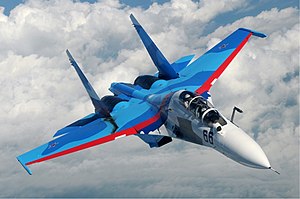Sukhoi Su-30
| Su-30 | |
|---|---|
 |
|
| Russian Air Force Su-30 over Russia | |
| Role | Multirole fighter |
| Manufacturer | KnAAPO, Irkut Corporation |
| Designer | Sukhoi |
| First flight | 31 December 1989 |
| Introduction | 1996 |
| Status | In service |
| Primary users |
People's Liberation Army Air Force Russian Air Force Vietnam People's Air Force Royal Malaysian Air Force |
| Produced | 1992–present |
| Number built | 540+ |
| Unit cost |
Su-30MK2: US$37.5 million in 2012
|
| Developed from | Sukhoi Su-27 |
| Variants |
Sukhoi Su-30MKI Sukhoi Su-30MKK Sukhoi Su-30MKM |
The Sukhoi Su-30 (Cyrillic: Сухой Су-30; NATO reporting name: Flanker-C) is a twin-engine, two-seat supermaneuverable fighter aircraft developed by Russia's Sukhoi Aviation Corporation. It is a multirole fighter for all-weather, air-to-air and air-to-surface deep interdiction missions.
The Su-30 started out as an internal development project in the Sukhoi Su-27 family by Sukhoi. The design plan was revamped and the name was made official by the Russian Defense Ministry in 1996. Of the Flanker family, only the Su-27, Su-30, Su-34 and Su-35 have been ordered into serial production by the Defense Ministry. All the others, such as Su-37, were prototypes. The Su-30 has two distinct version branches, manufactured by competing organisations: KnAAPO and the Irkut Corporation, both of which come under the Sukhoi group's umbrella.
KnAAPO manufactures the Su-30MKK and the Su-30MK2, which were designed for and sold to China, and later Indonesia, Uganda, Venezuela, and Vietnam. Due to KnAAPO's involvement from the early stages of developing Su-35, these are basically a two-seat version of the mid-1990s Su-35. The Chinese chose an older but lighter radar so the canards could be omitted in return for increased payload. It is a fighter with both air supremacy and attack capabilities, generally similar to the U.S. F-15E.
Irkut traditionally served the Soviet Air Defense and, in the early years of Flanker development, was given the responsibility of manufacturing the Su-27UB, the two-seat trainer version. When India showed interests in the Su-30, Irkut offered the multirole Su-30MKI, which originated as the Su-27UB modified with avionics appropriate for fighters. Along with its ground-attack capabilities, the series adds features for the air-superiority role, such as canards, thrust-vectoring, and a long-range phased-array radar. Its derivatives include the Su-30MKM, MKA, and SM for Malaysia, Algeria, and Russia, respectively. The Russian Air Force operates several Su-30s and has ordered the Su-30SM version.
...
Wikipedia
